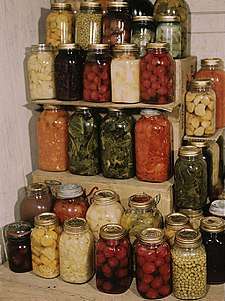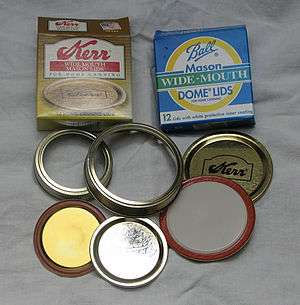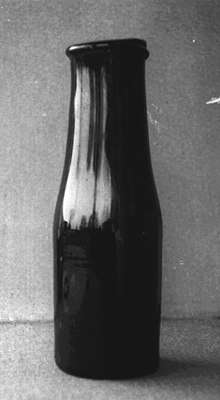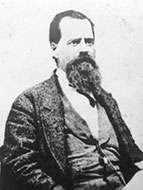Mason jar
A Mason jar, named after John Landis Mason who first invented and patented it in 1858, is a molded glass jar used in home canning to preserve food. The jar's mouth has a screw thread on its outer perimeter to accept a metal lid or ring (or "band"). The band, when screwed down, presses a separate stamped steel disc-shaped lid against the jar's rim. An integral rubber ring on the underside of the lid creates a hermetic seal. The bands and lids usually come with new jars, but they are also sold separately. While the bands are reusable, the lids are intended for single-use when canning. Largely supplanted by other products and methods for commercial canning, such as tin cans and plastic containers, glass jars and metal lids are still commonly used in home canning.

Names
Mason jars are also called:
- Ball jars: in reference to the Ball Corporation, an early and prolific manufacturer of glass canning jars
- Fruit jars: for a common content
- Glass canning jars: a generic term reflecting their material and purpose
- Kilner jars: the major UK manufacturer
- Lightning fruit jars: another type of jar with a bail closure, were not as common as the screw-thread version, but they were popular for home canning in the late nineteenth and early twentieth centuries.
The jar

In the United States, standard-size Mason jars are made of soda-lime glass and come in two sizes: regular mouth, 2 3⁄8 in (60 mm) inner and 2 3⁄4 in (70 mm) outer diameter, and wide mouth, 3 in (76 mm) inner and 3 3⁄8 in (86 mm) outer diameter, versions. They are produced in a variety of volumes, including cup (half-pint), pint, quart, and half-gallon.
Use
In home canning, food is packed into the Mason jar, leaving some empty "head space" between the level of food and the top of the jar. The lid is placed on top of the jar with the integral rubber seal resting on the rim. A band is screwed loosely over the lid, allowing air and steam to escape. The jar is heat sterilized in boiling water or steam and the lid is secured. The jar is then allowed to cool to room temperature.
The cooling of the contents creates a vacuum in the head space, pulling the lid into tight contact with the jar rim to create a hermetic seal. Once cooled, the band is removed to prevent residual water between the jar threads and the lid from rusting the band. If the jar seal is properly formed, internal vacuum will keep the lid tightly on the jar. Most metal lids used today are slightly domed to serve as a seal status indicator. The vacuum in a properly sealed Mason jar pulls the lid down to create a concave-shaped dome. An improper or failed seal or microbial growth will cause the dome to pop upward.
History


French chef Nicolas Appert invented the method of preserving food by enclosing it in sealed containers. Among the earliest glass jars used for home canning were wax sealers, named in reference to the sealing wax that was poured into a channel around the lip to secure a tin lid. This process, which was complicated and error-prone, became popular in the late 1830s or early 1840s and was still used to seal fruit jars until about 1890. The wax sealing process was largely the only one available until other sealing methods were developed.[1] Competitors including jars with stoppers, spring wires, wire bails, cantilevered wires, and thumbscrews all proved less successful.
In 1858, a Vineland tinsmith named John Landis Mason (1832–1902) invented and patented a screw threaded glass jar or bottle that became known as the Mason jar (U.S. Patent No. 22,186.)[2][3] From 1857, when it was first patented, to the present, Mason jars have had hundreds of variations in shape and cap design.[1] After it was discovered that Mason's patent had expired, many other manufacturers produced glass jars for home canning using the Mason-style jar.[4] "Patent Nov 30th 1858," signifying the date of Mason's patent, was embossed on thousands of jars, which were made in many shapes, sizes, and colors well into the 1900s. Since they were made in such quantity and used for such long periods, many of them have survived to the present day.
The initial form of closure for the glass canning jar was a zinc screw-on cap, the precursor to today's screw-on lids. It usually had a milk-glass liner, but some of the earliest lids may have had transparent glass liners.[1] The cap screwed down onto a rubber ring on the shoulder of the jar, not the lip.[5] Between 1860 and 1900, many other patents were issued for Mason jar improvements and closures.[6] The more esoteric closures were quickly abandoned, and thus can fetch high prices in today's antique market. In 1903 Alexander Kerr introduced lids with a permanent rubber seal. His improved design in 1915 used the modern design.[7] Jars are closed with two-piece metal lids that seal on the rim. The jar lid has a rubber or rubber-like sealing surface and is held in place by a separate metal band.[1]
Mason sold the patents for the Mason jar, to the Sheet Metal Screw Company of Lewis R. Boyd in 1859. Boyd had patented a white "milk-glass" insert for the zinc screw lids to theoretically lessen the chances that food would be tainted by contact with the metal lid. In 1871, Mason partnered with Boyd in the Consolidated Fruit Jar Company which licensed Mason jar patents to numerous glass makers.[7] Mason applied for and received a United States trademark, which was registered on May 23, 1871, as U.S. Trademark no. 276. Letters of patent issued to Mason on May 10, 1870, for improvements to his fruit-canning jar was determined to be invalid as a result of a patent infringement case brought before the Southern District of New York on June 11, 1874. The court acknowledged that Mason had invented the jar in 1859, but he did not apply for a patent for an improved version of the fruit jar until 1868. In the meantime, several others had patented designs and Mason had known these jars were being produced and sold. The court ruled that Mason's delay in protecting his patent indicated he had abandoned his invention in the intervening years between 1859 and 1868 and had forfeited his patent. The court's decision allowed other manufacturers to patent, produce, and sell glass jars for canning.[8]
Variations of the Mason jar include the "Improved Mason" which sealed on a shoulder above the thread instead of below and the Atlas Strong Shoulder which had a reinforced shoulder area as the original design was subject to cracks from the stress at the sealing point. A new type of Mason jar known as a "bead" jar was introduced around 1910 to 1915. These continuous screw-thread jars were designed with a bead between the screw threads and the shoulder as a sealing surface. The Ball "Perfect Mason" jar, one of the most common jars of this style, was introduced around 1913 and produced until the mid-twentieth century. It had several variations, including a square-shaped jar.[1][9]
The Ball Corporation, which once dominated the market as the largest domestic manufacturer of home-canning jars, spun off its home-canning business in 1993. Ball Corporation was the largest domestic manufacturer of home canning jars. In 1939 the company manufactured fifty-four percent of all the canning jars made in the United States.[10] Ball ceased production of canning jars when its subsidiary, Alltrista, became a separate company in 1993. Alltrista was renamed Jarden Corporation in 2001.[11]
The decline in Mason jar manufacturing in North America is due to a sharp decline in popularity of home canning in the 1950s and 1960s with the rise of supermarket canned foods, and the consolidation of the U.S. canning jar industry.
Older styles of home canning jars are "Not Recommended" by the U.S.-based National Center for Home Food Preservation, the United States Department of Agriculture, and University Extension Services. These include: (A) those using a zinc cap and a rubber jar ring, and (B) those using a glass lid, wire bail, and rubber sealing ring. These provide "no definitive way to determine if a vacuum seal is formed."[12]
On August 15, 2017, the Registrar at National Day Calendar proclaimed National Mason Jar Day to be observed annually as a National Holiday on November 30th, beginning in 2017. This holiday was created by Unboxing the Bizarre. [13]
Collecting

Antique canning jars are often sold through antique stores and auction sites such as eBay. The value of a jar is related to its age, rarity, color, and condition. A jar's age and rarity can be determined by the color, shape, mold and production marks of the glass, and the jar's closure. Mason jars usually have a proprietary brand embossed on the jar. Early jars embossed with "Mason's Patent November 28th 1858" that date from the late 1850s to early 1860s closely match the illustrations of Mason's 1858 patents. Mouth-blown (or hand-blown) jars embossed with a version of "Mason's Patent November 28th 1858" were made about 1857 to 1908 and often had a ground lip as well. By 1908 semi-automatic machines manufactured the majority of these jars. Machine-made Mason jars that originated around 1909 have a sealing surface on a bead ledge below the threads. This type of jar dominated the market by the mid to late 1910s. Manufacturers continued to make jars with the beaded seal after the mid-twentieth century.[1] Ball's "Ideal" canning jar, which first appeared around 1915 and was discontinued in 1962, is one of the company's best-known jars and is popular among collectors.[14]
Colored jars were considered better for canning because the color blocked some light from reaching the food, which helps to retain flavor and nutritional value longer. Most antique jars that are not colorless are aqua or "Ball blue," a blue-green shade that was named for the Ball Corporation, a prevalent jar manufacturer. Most mouth-blown Mason jars embossed with some type of 1858 patent date were produced in aqua glass. The Ball brand of Mason jars were manufactured in several colors, but the most common color was the distinctive "Ball blue," which the Ball Corporation used in its jars from about 1910 to 1930. Mason jars with this particular color of glass may be attributed to Ball, since "virtually no other bottle or jar was made in that color."[1] More rarely, jars will turn up in amber, and occasionally in darker shades of green. Rarer still are cobalt blue, black, and milk-glass jars. Some unscrupulous dealers will irradiate jars to bring out colors not original to the jar.
Mason and similar jar manufacturers
- Anchor Hocking
- Leifheit
- Kilner is ubiquitous in Britain
- Bernardin is ubiquitous in Canada
- Newell Brands manufactures Ball, Golden Harvest, Jarden, Kerr and Penley branded Mason Jars.[15]
See also
- Flip-top
- Kilner jar – a UK design having glass lids with metal rings, still produced under that trademark.
- Weck jar – a German product similar to the Kilner but with two metal springs to fasten the glass lid, produced a little later than the Mason
- Fowler's Vacola jar – Australian product, an improved system using a single spring fastening and a metal lid.
Notes
- Bill Lindsey. "Fruit/Canning Jar Closures". Society for Historical Archaeology. Retrieved 2016-03-31.
- "John Landis Mason". National Inventors Hall of Fame. Retrieved 2016-03-31.
- Edmund F. Ball (1960). From Fruit Jars to Satellites: The Story of Ball Brothers Company, Incorporated. New York: Necomen Society in North America. p. 8.
- Ball, pp. 12–13.
- Food Bottles, The Society for Historical Archaeology
- Bill Lindsey. "Bottle Finishes & Closures, Part III: Types of Bottle Closures". Society for Historical Archaeology. Retrieved 2016-03-31.
- A PRIMER ON FRUIT JARS, Dave Hinson, Bottles and Extras, The Federation of Historical Bottle Collectors, 1996
- "The Consolidated Fruit Jar Company vs. James T. Wright. In Equity" in Samuel Blatchford (1875). Reports of Cases Argued and Determined in the Circuit Court of the United States for the Second Circuit: 1845–1887. 12. Auburn, NY: Derby and Miller. pp. 149–56. OCLC 68813078. Retrieved 2016-03-31.
- William F. Brantley (1975). A Collector's Guide to Ball Jars. Muncie, IN: Rosemary Humbert Martin. p. 55. OCLC 3104299.
- Frederic A. Birmingham (1980). Ball Corporation: The First Century. Indianapolis, IN: Curtis Publishing Company. pp. 139–40. ISBN 9780893870393.
- "Alltrista Corporation History". Funding Universe. Retrieved 2016-03-25. "Company History". Jarden Corporation. Retrieved 2016-03-25.
- Patti Griffith, University of Wyoming Cooperative Extension Service, in her reference to the use of older versions of Mason jar closures, explains, "Jars requiring a zinc cap and jar rubber or jars requiring a glass lid, wire bail, and jar rubber have not been recommended since 1989 because there is no definitive way to determine if a vacuum seal is formed." See Patti Griffith. "The Time is Ripe for Summer Melons" (PDF). Canner's Corner: Enjoying Summer's Bounty. Laramie, WY: University of Wyoming Cooperative Extension Service. MP-119-2 (2). Retrieved 2016-03-31.
- "NATIONAL MASON JAR DAY – November 30". National Day Calendar. October 6, 2017.
- Brantley, pp. 39–40.
- "Newell – Healthy Canning". Healthy Canning. Retrieved 2018-04-01.
References
- "Alltrista Corporation History". Funding Universe. Retrieved 2016-03-25.
- Ball, Edmund F. (1960). From Fruit Jars to Satellites: The Story of Ball Brothers Company, Incorporated. New York: Necomen Society in North America.
- Bandell, Brian (2014-03-13). "Company with $7B in sales now calls Boca Raton home". South Florida Business Journal. Retrieved 2016-03-31.
- Birmingham, Frederic A. (1980). Ball Corporation: The First Century. Indianapolis, IN: Curtis Publishing Company. ISBN 9780893870393.
- Blatchford, Samuel (1875). Reports of Cases Argued and Determined in the Circuit Court of the United States for the Second Circuit: 1845–1887. 12. Auburn, NY: Derby and Miller. pp. 149–56. OCLC 68813078. Retrieved 2016-03-31.
- "Brands". Jarden Corporation. Retrieved 2016-03-31.
- Brantley, William F. (1975). A Collector's Guide to Ball Jars. Muncie, IN: Rosemary Humbert Martin. OCLC 3104299.
- "Company History". Jarden Corporation. Retrieved 2016-03-25.
- Griffith, Patti. "The Time is Ripe for Summer Melons" (PDF). Canner's Corner: Enjoying Summer's Bounty. Laramie, WY: University of Wyoming Cooperative Extension Service. MP119-2 (2). Retrieved 2016-03-31.
- "Golden Harvest Canning Jars–History and Background". Jars for Canning. Retrieved 2016-03-31.
- Lindsey, Bill. "Historic Glass Bottle Identification & Information Website". Society for Historical Archaeology. Retrieved 2016-03-31.
External links
| Wikimedia Commons has media related to Mason jars. |
- Canning jars, images
- A Primer on Fruit Jars
- The Knox Glass Bottle Co. Mason Jars, research and illustrations
- Ball Perfect Mason Jars, Glass Bottle Marks
- Mason's Patent Nov. 30th 1858 Fruit Jars, Glass Bottle Marks